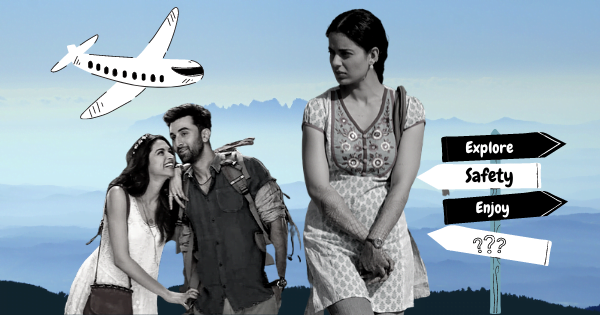When I began attending a residential college, 1500 miles away from where I lived, I was gripped with the curiosity to explore the opposite side of the country. Everyone I spoke to there, would tell me about the comedic pitfalls from driving up mountain roads, or group photographs clicked in the sunset backdrop. After 3 years of waiting for this, I finally decided to take off on my own. Media representations of solo trips tilt toward the notion of self-discovery or worse still, finding love, and restrict themselves to international settings. Indian movies like Queen and Tamasha feature female protagonists finding themselves abroad, adapting to the cultural climate there.

In most such movies, the trips cater to a select section of the female population that can afford to take weeks off from daily chores, and do so, at a large expense. At the other extreme is the portrayal of traveling in India, which focuses more on the friends in whose company the trip is undertaken, than the trip itself. My trip to Dalhousie in Himachal Pradesh lay in that underrated intersection, between traveling in India and traveling alone.
The Safety Dilemma
“Isn’t it unsafe?”
This was a question that popped up from many friends, when I decided to go, not only on this trip, but in any form of inter-state travel, bringing me to the other reason why traveling in a group is popular.
We cannot hide the fact that safety levels for women vary across socio-economic sections. Staying in apartments guarded by security officers or having reliable means of transportation are privileges. But this isn’t an assurance that holds up uniformly, given that several cases of harassment and sexual crimes have involved perpetrators previously known in some capacity to victims. That being said, the backgrounds we belong to define the people and environments we interact with, or are prevented from interacting with, in our day-to-day lives.
Media representations of solo trips tilt toward the notion of self-discovery or worse still, finding love, and restrict themselves to international settings. Indian movies like Queen and Tamasha feature female protagonists finding themselves abroad, adapting to the cultural climate there. In most such movies, the trips cater to a select section of the female population that can afford to take weeks off from daily chores, and do so, at a large expense.
My choice to go on this trip was made because I could spare a few thousand rupees towards traveling for leisure. It was within similar circles of girls, that I found an unwillingness to travel and live alone in India, heavily based on concerns of safety. I heard many female friends speak of how much safer a solo trip would be, had it been abroad. Safety is thrown around generically, which makes it all the more necessary to understand when it is a mere luxury and when it truly speaks of women as a whole.
Dissecting Notions of Safety
When I went on that trip, I had to spend a great deal of time in crowded buses and dimly lit stops in mountainous terrain with poor connectivity, that my more affluent friends may have perceived as nothing short of a dramatic movie beginning. The hesitancy to send daughters to live and travel alone in India, is valid in the context of surging rates of crime. I am not trying to downplay the importance of speaking about safety, but there is a fine line where this simply becomes a limiting factor for young women, with safety concerns acting as agents of control.

I found many parents who would simply refuse to let their daughters study or intern in a different city, after passing out from school, despite having the means to do so. Being conditioned this way resulted in uncertainty among the same friends when I’d ask them about journeying in the vacations. Being withheld from opportunities to remain alone affected the extent to which many were comfortable with it when presented with that chance, however close to home. One reason I went on that solo trip was because the girls I asked, well into their college years, preferred the comfort of a large group, as opposed to a duo. They spoke of traveling, meeting strangers and adapting to local establishments in an alien sense.
Also read: Women Travelling Solo And The Added Baggage They Carry
I once came across a post by a girl that spoke of how she passed her time in cab rides in constant anxiety, staring at the navigation system to ensure that the driver followed her designated route. This was widely empathised with for portraying how poor safety levels were.
Maybe the post was true in the sentiment conveyed, but it also propagated platitudes that we take for granted. There is a subtle distinction between staying anxious, and staying alert, regardless of the mode of transportation used. But that simply scratches the surface. How many women possess the luxury to say no to government buses, shared auto rickshaws and walking, be it at day or night? Having to stay anxious in all scenarios involving unknown men and localities, is problematic in the bias it displays. How responsible is it to encourage a culture of spending time in such environments remaining paranoid about where we are and when we reach?
I heard many female friends speak of how much safer a solo trip would be, had it been abroad. Safety is thrown around generically, which makes it all the more necessary to understand when it is a mere luxury and when it truly speaks of women as a whole.
Watching these movies with women on solo trips abroad inevitably brings up a pertinent question—How many Indian women can afford to even state international safety standards as excuses for not traveling alone here, let alone use them? The traveling abroad alternative is also linked to holding an added mistrust towards the non-upper class non-upper caste man while exploring Indian terrain, based on unfounded generalizations of where women are really safe. Such a mode of thought rarely functions in foreign trips, thus making it a convenient alternative for those who can use it.
The Problem of Sheltering Oneself
In such a system, a walk to the market that an average woman might take through a sparsely populated area might be treated as avoidable. Caution and demeanour are traits that adapt with exposure, and constantly backing away for safety, obstructs the very chance of allowing these to develop. Yes, it is true that there are incidents, but when I spoke of traveling alone, I heard concerns that transcended the boundaries of safety, because they no longer applied to all women.

How many of us can avoid traveling this way when we depend on solo traveling for livelihoods?
The conversations I had, highlighted how the privilege to stay safe was not recognised by many women, and oftentimes used as a reason to shelter oneself. They convert being cautious to being fearful. We pay for such preventive measures adopted by continuing to remain in bubbles.
Also read: Female Solo Travel: A Step Into Adulthood And Its Independence
My college experiences led me to conversations that I may not have had, had I found a circle to travel with after going that far to study. We are at an age where more female travelers sit across Indian landscapes because movements in the past have paved the way for it. It is hence imperative that we ask for more inclusive female representation, when presenting the solo traveler narrative. It is also high time we began including privilege in conversations of safety and acknowledging it, when it serves to exist as merely a shackle to progress, and exploration.
Featured Image Source: Feminism In India
About the author(s)
Spatika is an undergraduate student and INSPIRE Fellowship recipient, at the Indian Institute of Science Education and Research, in Mohali. Her interests range from the scientific end of neuroscience to the literary end of writing. Her writings have been published or are forthcoming in Live Wire, Delhi Poetry Slam, The New Verse News, Sublunary Review and Brown Girl Magazine.




